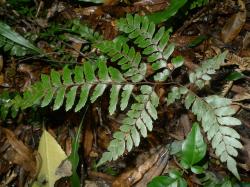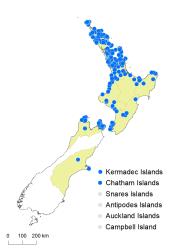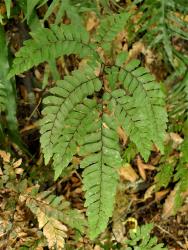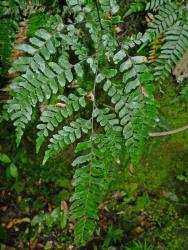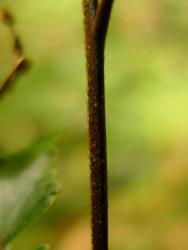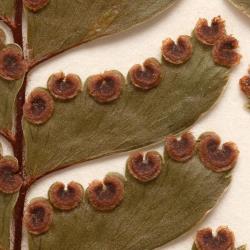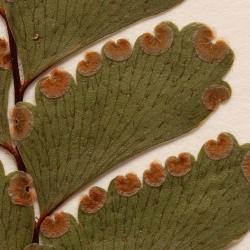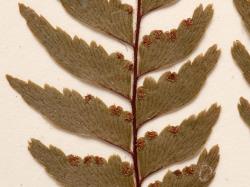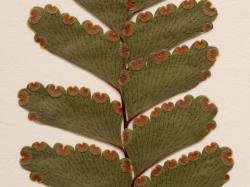- = Adiantum viridescens Colenso, Trans. & Proc. New Zealand Inst. 27: 400 (1895)
Rhizomes long-creeping, up to 250 mm long (in herbarium specimens), 1.5–3 mm diameter, with stipes inserted 5–40 mm apart; bearing scales; stolons and tubers absent. Rhizome scales narrowly ovate, 2.0–6.5 mm long, 0.3–0.6 mm wide, red-brown, concolorous. Fronds 170–850 mm long. Stipes 50–530 mm long, dark brown, bearing spreading red-brown scales up to 6 mm long and 0.4 mm wide proximally, and shorter antrorse hairs distally. Rachises dark brown, sulcate, bearing antrorse red-brown hairs. Laminae usually 3-pinnate, or rarely 2-pinnate in small fronds or 4-pinnate in large fronds, broadly ovate or ovate, 90–360 mm long, 60–275 mm wide, dark green on both surfaces, herbaceous, glabrous or bearing stiff dark hairs on the abaxial surface. 1–5 pairs of divided primary pinnae below long pinnate apex, widely spaced especially proximally, ovate; costae hairy; the longest pinnae at or near the base, 40–220 mm long, 20–150 mm wide, apices acute to acuminate, bases stalked, divided into secondary pinnae. 1–3 (or very rarely 0) pairs of secondary pinnae on the proximal primary pinnae divided into tertiary pinnae, the remainder undivided; the basal basiscopic one the longest, ovate or narrowly ovate, 15–105 mm long, 10–48 mm wide, apices acute to acuminate, bases stalked. Rarely, the tertiary pinnae divided into 1–2 pairs of quaternary pinnae. Longest ultimate lamina segments oblong, curving acroscopically, 8–26 mm long, 3–9 mm wide, apices obtuse, acroscopic margins irregularly lobed, basiscopic margins ± entire, bases stalked, with stalks attached in one corner. Reflexed lamina flaps reniform, glabrous.
Adiantum fulvum is usually 3-pinnate at the base, but rarely large fronds may be 4-pinnate and small fronds only 2-pinnate. The species has oblong, ultimate segments that curve acroscopically at their apices; their abaxial surfaces are green, and the stalks are attached in the corners. The species is dimorphic, the abaxial lamina surfaces being either hairy or glabrous. The stipes, rachises and pinna costae bear antrorse red-brown hairs, and the “indusia” are reniform and glabrous. Large, 4-pinnate fronds can resemble small plants of A. formosum, but the stipes and rachises are hairy, whereas in A. formosum they are rough and glabrous; the “indusia” of A. formosum are lunulate in shape rather than truly reniform as in A. fulvum; and the ultimate lamina segments of A. formosum are generally shorter than in A. fulvum (9–16 mm long, cf. 8–26 mm long).
North Island: Northland, Auckland, Volcanic Plateau, Gisborne, Taranaki, Southern North Island.
South Island: Western Nelson, Sounds-Nelson, Canterbury.
Kermadec Islands, Chatham Islands.
Altitudinal range: 0–450 m.
Adiantum fulvum occurs on the Kermadec Islands, and in lowland to montane areas of the North Island from Te Paki to Wellington, but is common only from Northland to the Bay of Plenty, with more scattered populations south to Wellington. It is absent from much of the central North Island. In the South Island it is confined to the Marlborough Sounds and north-west Nelson, but was formerly known from Oxford, Canterbury (WELT P008398), and Banks Peninsula (Akaroa, Kirk, CHR 291742; J.F. Armstrong, CHR 633293), where it has not been collected since the 19th century, but from where the species was first described (Raoul 1846). It grows from near sea level, reaching 450 m in the Tutamoe Range, Northland. A single collection (AK 300996) has been made from the Chatham Islands.
Adiantum fulvum grows on the ground under kauri, podocarp, broadleaved and coastal forest, and under mānuka, kānuka and coastal scrub, usually on drier ground. It is found on streambanks, river terraces and clay banks, in gullies, among rocks, on rubbly slopes, on tracksides, road banks and rock faces, on steep hillsides, and on coastal cliffs. It occurs on greywacke, limestone and mudstone rock.
It is possible that Adiantum fulvum hybridises occasionally with A. cunninghamii. One collection (AK 353971) has hairs on the abaxial pinna surfaces and vestigial hairs on the rachises, but the sori are over-mature and the nature of the spores unknown (Brownsey et al. 2019).
n = 58 (Brownlie 1965, as A. fulvum); 2n = 116 (Murray & de Lange 2013, as A. viridescens).
Adiantum fulvum was described by Raoul (1846) from a collection he made on Banks Peninsula in 1843. There is also a collection made by J.F. Armstrong in 1864, and another by Thomas Kirk from Akaroa, probably in 1876. However, it has not been collected on Banks Peninsula since that date.
The hairy and glabrous forms of A. fulvum were previously recognised as A. fulvum and A. viridescens (Parris & Croxall 1974). However, Brownsey et al. (2019) found that the two forms could not be distinguished by any character other than the presence or absence of hairs on the abaxial lamina surface, and proposed that they be regarded as dimorphic character states within A. fulvum, consistent with the treatment of other dimorphic Adiantum species in New Zealand.
Adiantum fulvum is recorded here for the first time from the Kermadec Islands (AK 326202).



